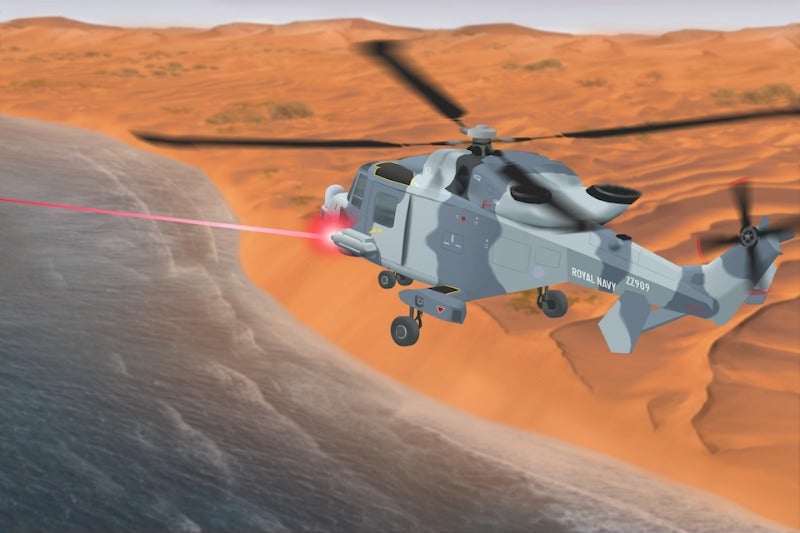Directed energy weapons (DEWs) could provide a number of capabilities and advantages over traditional weapons due to their speed-of-light delivery, precision engagement, controlled/scalable effects, logistical benefits, and low cost per shot. Furthermore, DEWs are silent, offer plausible deniability, can travel immense distances relative to conventional weapons, and engage multiple targets. Consequently, these advantages will support the development of a wide spectrum of military equipment and capabilities.
Listed below are the key defence and technology trends impacting the DEW theme, as identified by GlobalData.
Growing demand for counter unmanned air vehicles and drones
DEWs have begun to be used in many operational areas where the threats have increased and become more complex. Because of the proliferation of UAVs and their growing threat to critical facilities, the majority of DEWs are being developed for use against UAVs and small crafts. Directed Energy Weapons, such as High Energy Laser and High Powered Microwave weapons, are often used against drones. The U.S. Air Force has used a Raytheon-made high-energy laser to destroy dozens of small drones.
How well do you really know your competitors?
Access the most comprehensive Company Profiles on the market, powered by GlobalData. Save hours of research. Gain competitive edge.

Thank you!
Your download email will arrive shortly
Not ready to buy yet? Download a free sample
We are confident about the unique quality of our Company Profiles. However, we want you to make the most beneficial decision for your business, so we offer a free sample that you can download by submitting the below form
By GlobalDataNeed for anti-ballistic missile systems to fuel growth of the market
The demand for anti-ballistic missile systems is increasing due to the increased need to protect critical infrastructure and civilian lives. The expanding nuclear capabilities of North Korea and Iran, the rapid development of military arsenal in China, Russian aggression in Baltic Sea, and potential access to ballistic missiles by major terrorist groups such as Hezbollah and ISIS have driven the development of anti-ballistic missile systems. The US, Russia, and Israel have developed the A-35 anti-ballistic missile system, the Ground-Based Midcourse Defense, and the Arrow 3 counter-ICBM systems respectively.
Countries such as China, the UK, Italy, France, and India are currently developing improved versions of their existing ballistic missile protection systems. The anti-ballistic missile systems utilises targeted DEWs to destroy incoming ballistic missiles mid-flight. These systems are gaining significant importance due to the rapid proliferation of ballistic missiles amongst insurgent groups and rouge nations.
DEWs against hypersonic missiles
Trends indicate that missiles of the future will be faster and stealthier with increased lethality. Technology leaders are developing hypersonic missiles that cannot be intercepted or even targeted. Significantly reduced warning times (a factor of threats being launched at short range and/or detected late) is one of the biggest problems. DEWs can provide high speed reaction times and are likely to become the most important part of hypersonic missile defence systems.
Beam combining technology
Beam combining technology is able to achieve enhanced power density on target, reducing defeat times, and increasing engagement range. The combination of beams can be performed using three techniques – coherent beam combining, incoherent beam combining, and spectral beam combining. Companies such as Lockheed Martin, Northrop Grumman, BAE Systems, Raytheon, Qinetiq, and Boeing are investing in these techniques to improve military capabilities.
The advent of these techniques and the successes achieved by the researchers will equip military forces with weapons that will transform the nature of modern-day warfare. High power laser beams are expected to be evaluated for application in defensive and offensive applications by military forces.
Increasing demand for airborne DEWs
Airborne DEWs have long been sought after for military organisations. Recent advancements in technology, coupled with years of effort by scientists worldwide, have facilitated substantial breakthroughs in airborne laser systems. For instance, Northrop Grumman Corporation was awarded a contract by the U.S. Air Force Research Laboratory (AFRL) for the development of a new laser system which will protect fifth-generation US fighters from incoming missiles from hostile forces. The US Air Force was scheduled to begin the initial testing of the system in 2019 and plans to install the system on both in-service and future aircraft.
The US Army is also aiming to deploy high energy laser systems onto its multi-mission helicopters. The key challenge to the use of helicopter mounted laser systems is the capability of the helicopter to generate the required amount of power in combat conditions.
Preventing collateral damage
Conventional weapons, such as guided missiles and rockets can stop threats at long distances and create large areas of effect. These weapons can cause unwanted collateral damage, especially when the targeting process is not high precision. Directed Energy Weapons (DEWs) offer significantly improved accuracy and precision compared to existing conventional weapons.
Need for crowd control and identified personnel deterrence by homeland security forces
The use of firepower by Homeland Security agencies in urban areas on civilian targets is banned by domestic and international laws worldwide. This has driven the demand for non-lethal DEWs. Driven by the progress in technological innovations, various crowd control and personnel incapacitation systems have been introduced for use by Homeland Security Forces. For example, in the US, the use of electroshock stun gun, Taser, became an effective non-lethal option for personnel deterrence by the law enforcement agencies. The LRAD have been deployed on several occasions worldwide and have proven effective without causing any severe injury to the targets.
These weapons are gradually becoming more common for law enforcement agencies. Improved technological devices for non-lethal use of force are expected to replace some existing DEWs over the years.
This is an edited extract from the Directed Energy Weapons (Defense) – Thematic Research report produced by GlobalData Thematic Research.








Related Company Profiles
QinetiQ Ltd
Homeland Security Corporation
Genasys Inc
Boeing China Inc
BAE Systems Plc